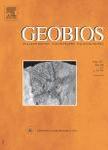版权所有:内蒙古大学图书馆 技术提供:维普资讯• 智图
内蒙古自治区呼和浩特市赛罕区大学西街235号 邮编: 010021

作者机构:Université Claude-Bernard Lyon 1 UMR 5565 du CNRS Paléontologie Stratigraphique et Paléoécologie F- 69622 Villeurbanne cedex 27-43 Bd du 11 Novembre France Université de Bourgogne UMR 5561 du CNRS Paléontologie Analytique et Géologie Sédimentaire Centre des Sciences de la Terre F- 21000 Dijon 6 Bd Gabriel France
出 版 物:《Geobios》 (Geobios)
年 卷 期:1997年第30卷第SUPPL. 2期
页 面:293-301页
学科分类:0710[理学-生物学] 070903[理学-古生物学与地层学(含:古人类学)] 0709[理学-地质学] 07[理学] 0708[理学-地球物理学] 0903[农学-农业资源与环境] 0825[工学-航空宇航科学与技术] 0704[理学-天文学]
主 题:Brachiopoda Devonian Heterochrony evolution Jurassic Life history strategies Silurian
摘 要:Since the beginning of the Paleozoic articulate brachiopods evolution has been punctuated by numerous morphological innovations, some leading to group diversification. Such innovations appear to have been related to transgressive periods that increase potentially favorable areas for colonization. Some morphological innovations appear to be only a consequence of opportunistic strategies matching heterochrony. Such strategies are demonstrated in fossil Brachiopoda by small-sized adults, high juvenile mortality, population taphonomy and community diversity. Growth heterochronies are paedomorphic processes (and often progenetic) resulting in ephemeral morphological innovations or in stable morphological features that are exploited by the group (species to family) over several million years. Four examples are presented, corresponding to different time scales and involving profund, lasting innovations: 1/ The Jurassic terebratulid Cererithyris (Bathonian-Callovian boundary), where C. nutiensis is differentiated from C. intermedia by intermediary opportunistic populations fixed on ephemeral substrates (corals) over normally muddy soft bottoms;2/ The Jurassic ornithellid zeillerid group (Bathonian-Callovian) that exhibits morphologic iterations corresponding to repeated exploitations of shelly substrates resulting from condensation during trangressions;3/ The Toarcian-Aalenian rhynchonellid genus Homeorhynchia whose miniaturized populations on muddy substrates appears to be either reversible or to have resulted in evolutionary changes;4/ The Devonian asymmetric chonetoids whose spinal asymmetry is associated with progenesis linked to an epiplanktic mode of life.